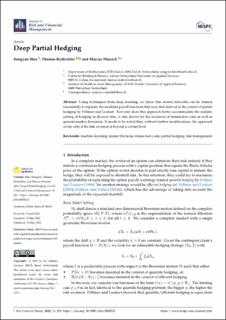Please use this identifier to cite or link to this item:
https://doi.org/10.21256/zhaw-25472Full metadata record
| DC Field | Value | Language |
|---|---|---|
| dc.contributor.author | Hou, Songyan | - |
| dc.contributor.author | Krabichler, Thomas | - |
| dc.contributor.author | Wunsch, Marcus | - |
| dc.date.accessioned | 2022-08-19T08:34:21Z | - |
| dc.date.available | 2022-08-19T08:34:21Z | - |
| dc.date.issued | 2022 | - |
| dc.identifier.issn | 1911-8066 | de_CH |
| dc.identifier.issn | 1911-8074 | de_CH |
| dc.identifier.uri | https://digitalcollection.zhaw.ch/handle/11475/25472 | - |
| dc.description.abstract | Using techniques from deep learning, we show that neural networks can be trained successfully to replicate the modified payoff functions that were first derived in the context of partial hedging by Föllmer and Leukert. Not only does this approach better accommodate the realistic setting of hedging in discrete time, it also allows for the inclusion of transaction costs as well as general market dynamics. It needs to be noted that, without further modifications, the approach works only if the risk aversion is beyond a certain level. | de_CH |
| dc.language.iso | en | de_CH |
| dc.publisher | MDPI | de_CH |
| dc.relation.ispartof | Journal of Risk and Financial Management | de_CH |
| dc.rights | http://creativecommons.org/licenses/by/4.0/ | de_CH |
| dc.subject | Machine learning | de_CH |
| dc.subject | Risk management | de_CH |
| dc.subject | Transaction cost | de_CH |
| dc.subject | Market friction | de_CH |
| dc.subject | Partial hedging | de_CH |
| dc.subject.ddc | 006: Spezielle Computerverfahren | de_CH |
| dc.subject.ddc | 332.6: Investition | de_CH |
| dc.title | Deep partial hedging | de_CH |
| dc.type | Beitrag in wissenschaftlicher Zeitschrift | de_CH |
| dcterms.type | Text | de_CH |
| zhaw.departement | School of Management and Law | de_CH |
| zhaw.organisationalunit | Institut für Wealth & Asset Management (IWA) | de_CH |
| dc.identifier.doi | 10.3390/jrfm15050223 | de_CH |
| dc.identifier.doi | 10.21256/zhaw-25472 | - |
| zhaw.funding.eu | No | de_CH |
| zhaw.issue | 5 | de_CH |
| zhaw.originated.zhaw | Yes | de_CH |
| zhaw.pages.end | 223 | de_CH |
| zhaw.publication.status | publishedVersion | de_CH |
| zhaw.volume | 15 | de_CH |
| zhaw.publication.review | Peer review (Publikation) | de_CH |
| zhaw.webfeed | W: Spitzenpublikation | de_CH |
| zhaw.author.additional | No | de_CH |
| zhaw.display.portrait | Yes | de_CH |
| zhaw.monitoring.costperiod | 2022 | de_CH |
| Appears in collections: | Publikationen School of Management and Law | |
Files in This Item:
| File | Description | Size | Format | |
|---|---|---|---|---|
| 2022_Hou-Krabichler-Wunsch_Deep-partial-hedging_jrfm.pdf | 600.17 kB | Adobe PDF |  View/Open |
Show simple item record
Hou, S., Krabichler, T., & Wunsch, M. (2022). Deep partial hedging. Journal of Risk and Financial Management, 15(5), 223. https://doi.org/10.3390/jrfm15050223
Hou, S., Krabichler, T. and Wunsch, M. (2022) ‘Deep partial hedging’, Journal of Risk and Financial Management, 15(5), p. 223. Available at: https://doi.org/10.3390/jrfm15050223.
S. Hou, T. Krabichler, and M. Wunsch, “Deep partial hedging,” Journal of Risk and Financial Management, vol. 15, no. 5, p. 223, 2022, doi: 10.3390/jrfm15050223.
HOU, Songyan, Thomas KRABICHLER und Marcus WUNSCH, 2022. Deep partial hedging. Journal of Risk and Financial Management. 2022. Bd. 15, Nr. 5, S. 223. DOI 10.3390/jrfm15050223
Hou, Songyan, Thomas Krabichler, and Marcus Wunsch. 2022. “Deep Partial Hedging.” Journal of Risk and Financial Management 15 (5): 223. https://doi.org/10.3390/jrfm15050223.
Hou, Songyan, et al. “Deep Partial Hedging.” Journal of Risk and Financial Management, vol. 15, no. 5, 2022, p. 223, https://doi.org/10.3390/jrfm15050223.
Items in DSpace are protected by copyright, with all rights reserved, unless otherwise indicated.